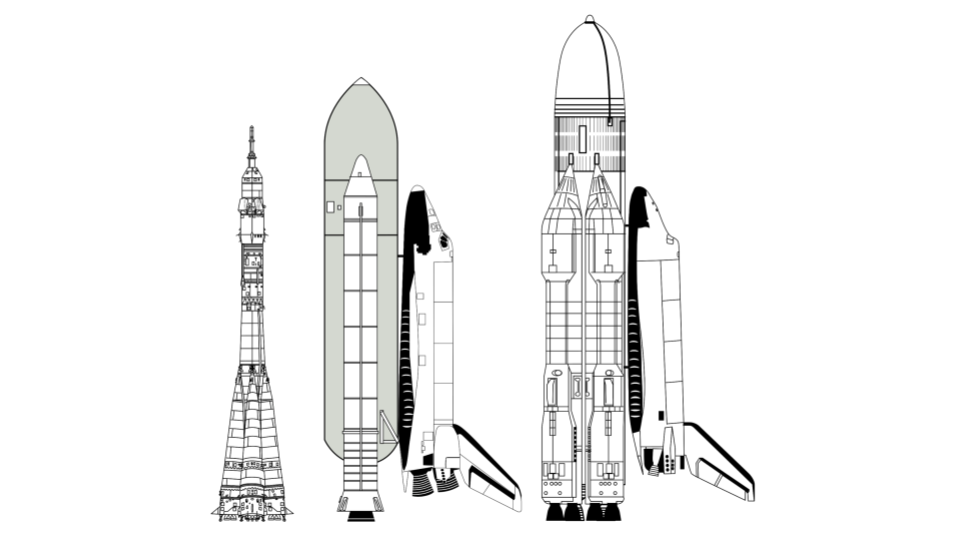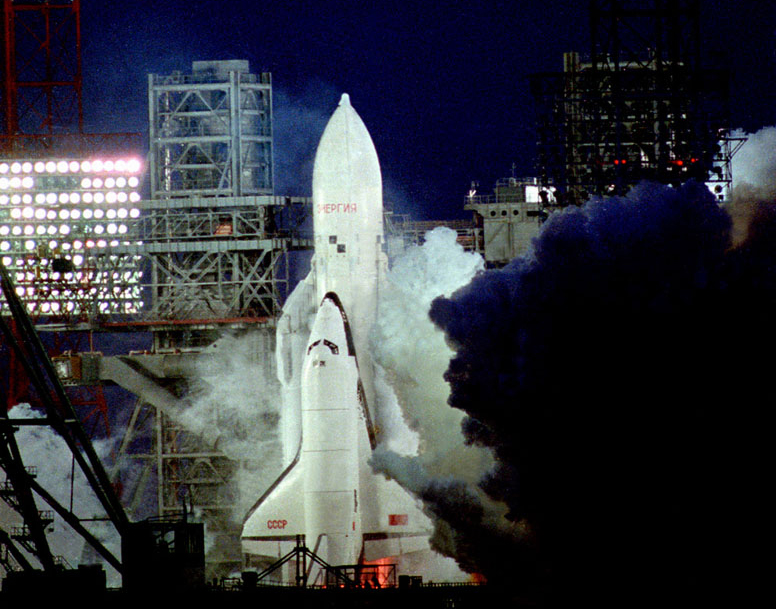
This past Monday, November 15, marked the 33rd anniversary of the first and only launch of the Soviet Buran Space Shuttle.
The Buran program, officially known as VKK or “air space ship”, was started in 1974 in response to Soviet fears that the United States was going to use their Space Shuttle to nuke them or otherwise interfere with their space assets in orbit.
In traditional Soviet fashion, Buran development proceeded with extensive ground and then flight testing, just like with the Soyuz spacecraft. This resulted in small models which were launched onto high suborbital trajectories to test the heat shield, lots of full orbiter fuselage test articles for different subsystems, and even one which could take off under its own power to practice landings with two pairs of jet engines. The orbital vehicle was going to be outfitted with one pair of jet engines which could, in theory, allow it to have multiple landing attempts, unlike the U.S. shuttle. This atmospheric test vehicle was called OK-GLI, and it was piloted by a crew of two. It flew 25 times between 1985 and 1988.
The Buran orbiter was largely similar to the American vehicle it copied but with several key improvements. Most notably, since its Energia rocket was intended to launch non-orbiter payloads, the Buran orbiter lacked the large and expensive main engines. These main engines were simplified and put on the expendable core stage of the Energia rocket. The orbiter itself only had orbital maneuvering engines. Moving the main engines allowed a five-ton increase in payload capacity compared to the U.S. shuttle.

Because the Soviet Union did not have the technology to develop large solid motors like those used on the Shuttle, the four boosters on the Energia used liquid engines. Each booster had one RD-170 engine, which powered four nozzles with one turbopump. To this day, it is the most powerful liquid-propellant rocket engine ever made, putting out an incredible 7.9 meganewtons of thrust. For comparison, all nine engines on the first stage of Falcon 9 Block 5 put out 7.6 meganewtons of thrust.
The first flight orbiter, OK-1.01, was delivered to Baikonur in 1984 only partially assembled. This partial assembly was required because the Soviets literally did not have a plane large enough to be capable of transporting the entire thing, so instead, components were flown on a modified M-4 bomber from the factory near Moscow to Baikonur.
Before Buran could fly, the rocket that would put it into orbit — the Energia — needed to be tested. Energia was intended to launch a variety of payloads, not just the Buran orbiter. The first launch of Energia was in May 1987, launching the Polyus space laser battle station. Unfortunately, or perhaps fortunately for the tensions in the Cold War at the time, the launch failed because of a programming error. To keep the center of mass in a good spot for launch, Polyus was launched upside down. After separation from Energia, it was supposed to flip 180 degrees and finish orbital insertion. Instead, it flipped 360 degrees and sent itself into the southern Pacific Ocean. Because the launch failure had nothing to do with the rocket, Energia was cleared to launch the Buran.

The Soviets debated on the length of the first Buran mission, eventually deciding to only have a two-orbit flight. This would limit the number of systems needed to be ready for launch since a two-hour flight could be done on battery power without the help of an auxiliary power unit. A short flight also meant there was no need to deploy the payload bay doors and their radiators. This mission would prove the launch, some on-orbit systems, and the autonomous re-entry and landing.
OK-1.01 and its Energia were rolled out to the pad in October 1988. The launch was delayed several times for different technical problems, before finally launching in high wind conditions on November 15, 1988, at 0600 UTC. Just as planned, the uncrewed Buran was lifted almost all the way into orbit by Energia and successfully inserted itself into orbit minutes later. Two hours and twenty minutes later Buran deorbited itself, coming to a landing just to the side of the runway centerline — not bad for a spacecraft that’s flying itself. Igor Volk, who was to command the first crewed flight, flew a chase plane next to Buran as it landed.
The next planned flight of a Buran vehicle was going to be in 1991 using the second flight orbiter, but the Soviet Union collapsed before that could happen. The program was canceled in 1993. To add ultimate insult to injury, orbiter OK-1.01 and a flight-ready Energia rocket were destroyed in 2000 when its hangar roof collapsed due to lack of maintenance.
More Information
Buran info page (Astronautix)
Energia info page (Astronautix)
Polyus info page (Astronautix)




 Join the Crew!
Join the Crew!
 Escape Velocity Space News
Escape Velocity Space News
0 Comments